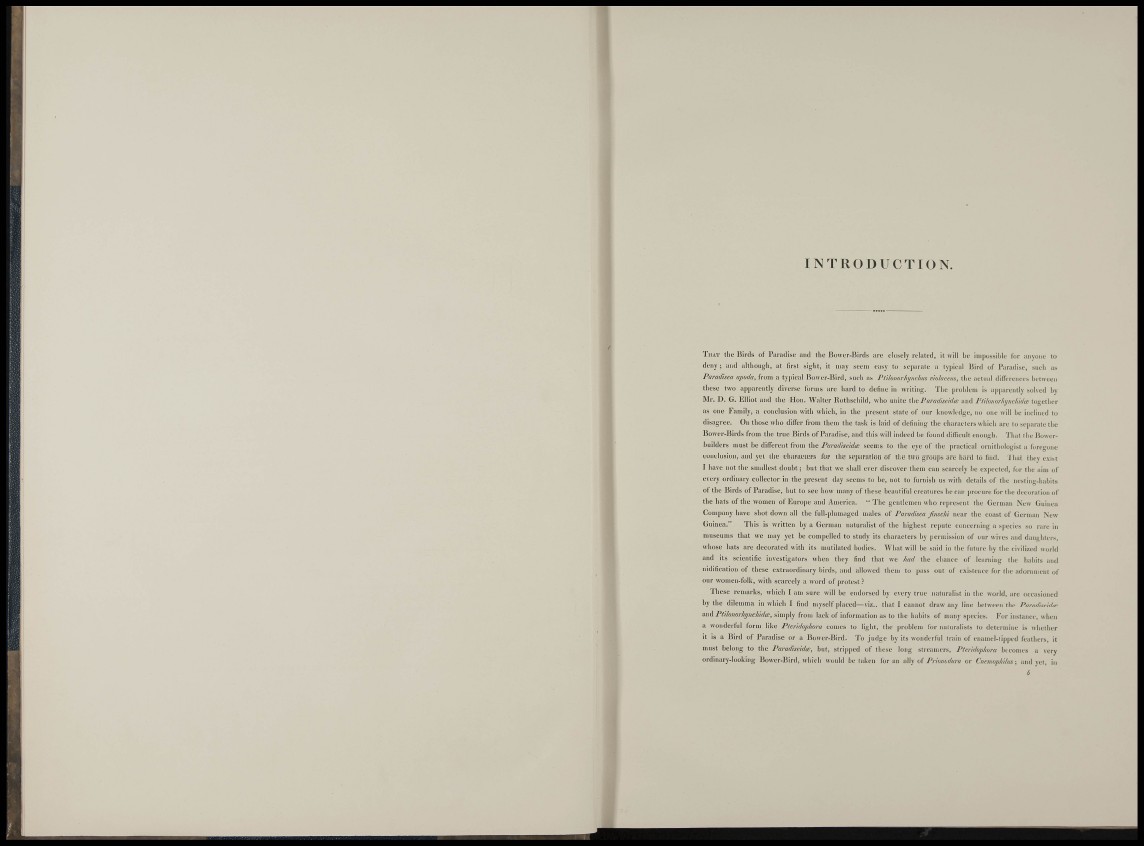
INTRODUCTION.
THAT tlie Birds of P:iriulise ami the Bowtr-Birds are closely related, it will be inii)(jssiljle for anyone to
deiiy ; and ultliougli, at first siglit, it may seem easy to ¡.eiiarate a tyjiieal Bird of Taradise, sneli as
P a r a d i s e a apoda, from a typical Boner-Bird, sncli as Pt i lumrlaj i ichm viukceus, the actual diirerences hetweeji
these two a|ijiareiitly diverse forms are hard to define in writing. 'J'he jiroljlem is apiiarently solved by
Mr. D. G. Elliot and the Hon. Walter Rothschild, who unite {\\ti P u r a d k e i d w and I ' t i lmwr h j n c / n d i e together
as one Family, a conclusion with whicli, in the present state of our knowledge, no one will he inclined to
disagree. On those who differ from them the task is laid of defining the characters wliieh are to separate the
Bower-Birds from the true Birds of Paradise, and this will indeed lie found difficidt eiiough. That ihe Bowerbuilders
must be different from \.\\e P u r a d i s d d c e seems to the eye of the |iractical ornithologist a foregone
conclusion, and yet the characters for the scjiaration of tlie two groujis are hard to find. That they exist
I have not the smallest doubt; hut that we shall ever discover thein can scarcely he exiiected, for the aim of
every ordinary collector in the present day seems to he, not to furnish us with details of the nesting-habits
of the Birds of Paradise, but lo see how many of these beautifid creatures lie can ])rocure for the decoration of
the hats of the women of Europe and America. " The gentlemen who represent the German New Guinea
Company have shot down all the full-i)lumaged males of Paradisea famhi near the coast of German New
Guinea." This is written by a German naturalist of the highest rcjiute concernhig a species so rare in
museums that we may yet be compelled to study its characters by iierniissioii of our wives and daughters,
whose hats are deeoralcd with its mutilated bodies. What will be said in the future by the civilized world
and its scientific investigators when they find that we h a d the chance of learning the habits and
nidification of these extraordinary birds, and allowed thcni to pass out of existence for the adornuicnt of
our women-folk, with scarcely a word of protest ?
These remarks, which I am sure will be emlorsed by every true iiaturalist in the world, are occasioned
by the dilemma in which I find myself jilaced—viz., that I cannot draw any line between the Paradiseidie
•MiA P t i l o n o r l u j n cMd i e , simply from lack of information as to the habits of inanj' sjiecies. For instance, when
a wonderful form like Pler idophor u conies to light, the problem for naluralists to determine is whether
it is a Bird of Paradise or a Bower-Bird. To judge by its wonderful train of eiiamel-iijjjjed leathers, it
must belong to the Paradiseidce, but, strijiped of these long streamers, Ptaidophura bicomes a very
ordinary-looking Bower-Bird, which would be taken for an ally u i P r k m d u r a or Cuemophilm •, and yet, in
0